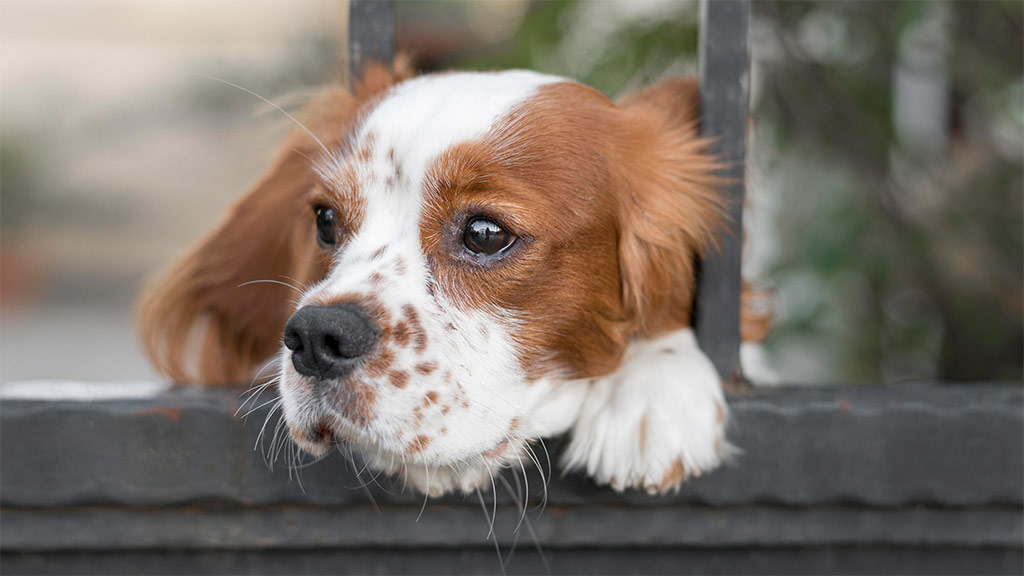Separation anxiety in dogs is an emotional distress that triggers when they are alone and or separated from their owners. Dogs with separation anxiety struggle to cope with loneliness, leading to intense fear and panic.
This condition is not just about a dog missing its owner; it’s a serious behavioral issue linked to an over-attachment that upsets a dog’s mental state. Studies suggest that every year, 20-40% of dogs suffering from separation anxiety come to behavioral specialists.
While any dog can develop this issue, it is more common in
- Dog breeds prone to clingy behavior like Toy Poodle, Dachshund, Maltese, Havanese, and Shih Tzu, for example.
- Dogs experiencing sudden life changes, such as a new home or routine shift
- Puppies that were not gradually trained for independence
- Dogs with a history of abandonment
- Rescued dogs
Understanding the emotional toll of separation anxiety is key to preventing and managing this behavioral disorder effectively.
Symptoms of Separation Anxiety in Dogs
The symptoms of separation anxiety in dogs can range from mild distress to destructive behaviors. Affected dogs show signs of extreme distress before their owner leaves. However, common signs of separation anxiety in dogs include
- Excessive barking
- Whining
- Howling
- Drooling
- Panting
- Pacing
- Attempts to escape
- Destructive chewing, especially around exit points like doors and windows
- Frequent urination or defecation indoors despite being house-trained
Causes of Separation Anxiety
The underlying causes of separation anxiety in dogs are complex. Understanding and identifying these causes can help pet parents take proactive steps to ease their dogs’ stress. Here are the main causes of separation anxiety in dogs:
- Sudden Changes in Routine
- Lack of Socialization
- Traumatic Experiences
- Genetic Predisposition
- Over-attachment to Owners
- Lack of Independence Training
- Moving to a New Home or Environment
- Loss of a Family Member or another Pet
- Excessive Time Spent Together Without Alone Training
- Neglect or Inconsistent Care
3 Strategies for Preventing Separation Anxiety in Dogs
Preventing separation anxiety in dogs is a challenge many pet owners face. To deal with this challenge, we asked industry experts to share practical strategies. Here’s what our experts have to say:
-
- Create a Departure Ritual
- Train and Stimulate
- Normalize Alone Time
Create a Departure Ritual
One strategy for preventing separation anxiety in dogs is creating a consistent departure ritual.
I’ve seen how urban life in Chicago, like the constant hum of Logan Square’s streets or the rush of downtown commutes, can leave dogs feeling unsettled when their owners head out.
What I do with my own pup, and what I recommend to my clients, is a simple routine:
A quick walk around the block, a treat tucked into a puzzle toy, and a calm ‘see you soon’ before I go.
It’s like a signal that says everything’s normal and they’re safe.
George Kunatz, Owner, George’s Floofing Friends
Train and Stimulate
Two main things for me.
Firstly, you need to lay the groundwork and train your dog so that they know being alone is okay and that you will be back.
I make sure that with my puppies I do gradual training where I’m away from them a few minutes at a time and I reward good behavior when I return. This can involve using a dog crate as a training aid to start with. This is critical in teaching your puppy that they can use this alone time to distress and to relax, while getting a reward and affection when you return.
Secondly, I like to use brain-stimulating feeders so that the dog has to work and “hunt” for food when you are not there (much like in the wild). Hiding a few treats in these mats will stimulate your dog and prevent boredom and destructive behavior.
With these two things, I make sure that my dogs aren’t stressed and don’t suffer from separation anxiety.
Andrew Nolan, Blogger, All About Cockapoos
Normalize Alone Time
The best strategy for me, hands down, was consistency — I made sure to leave her alone every single day, even if just for ten minutes.
When I first got her, it was the dead of winter, and after spending the day outside with her, I had no desire to go on solo walks.
Thankfully, my apartment building had a gym, so I started going — sometimes just for 15-20 minutes.
This small habit not only got me into fitness for the first time in my life but also helped my pup learn that being alone was just a normal part of the routine.
Over time, I gradually increased the duration, and now, three years later, she has zero issues with separation.
My biggest advice? Get a crate, be consistent, and normalize alone time from day one!
Julie Goldberg, Therapist, Third Nature Therapy
Final Words!
Preventing separation anxiety in dogs requires patience, consistency, and an understanding of their emotional needs.
As our experts have shared, small, intentional actions — like creating a calm departure ritual, providing mental stimulation, and normalizing alone time — can make a significant difference.
Dogs thrive on structure and reassurance, and when owners take proactive steps, they help their pets develop confidence and independence.
Remember, separation anxiety doesn’t have to be a lifelong struggle. With the right strategies, pet parents can build a secure environment where dogs feel safe, even when home alone.
FAQs- Separation Anxiety in Dogs
- How do I know if my dog has separation anxiety?
Dogs with separation anxiety show signs like excessive barking, whining, howling, drooling, pacing, destructive chewing, indoor accidents, and escape attempts when left alone. If your dog exhibits these behaviors only when you’re away, they may have separation anxiety.
- What causes separation anxiety in dogs?
Separation anxiety can be triggered by sudden routine changes, lack of socialization, traumatic experiences, genetic predisposition, over-attachment to owners, moving to a new home, or the loss of a family member or pet.
- Can separation anxiety in dogs be cured?
While separation anxiety can’t always be “cured,” it can be managed and improved with training, gradual alone-time conditioning, mental stimulation, and the creating of a predictable routine. Some severe cases may require professional behavioral help.
- What are the best ways to prevent separation anxiety in dogs?
Preventing separation anxiety starts with training dogs to be comfortable alone, using interactive toys, creating a departure ritual, and gradually increasing the time they spend by themselves. Consistency and positive reinforcement are key.
- Should I use a crate for a dog with separation anxiety?
A crate can be helpful if introduced properly, making it a safe, comfortable space rather than a punishment. However, some dogs with severe anxiety may panic in a crate, so it’s important to assess their comfort level and consult a trainer if needed.

